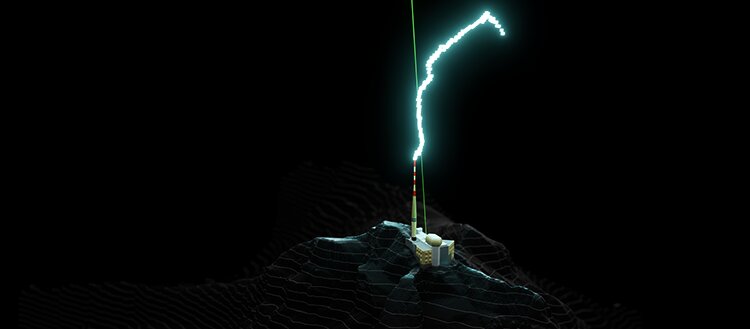Lightning kills as many as 24,000 people per year and causes as much destruction as it does fascination all over the world through things like forest fires, power outages, and broken infrastructure. The lightning rod that Benjamin Franklin developed is still the most effective means of protection. Even still, there are cases where these rods do not offer sufficient security for vital locations.
The Laser Lightning Rod (LLR) is a promising alternative created by a European team including the University of Geneva (UNIGE), École Polytechnique (Paris), EPFL, hes-so, and TRUMPF scientific lasers (Munich). After successfully putting the LLR through its paces on Säntis (in Switzerland), scientists have conclusive evidence of the device’s viability. Even in bad weather, the rod has a range of several hundred metres and may deflect lightning strikes. This study appears in the current issue of Nature PH๏τonics.
Lightning is one of the most extreme natural occurrences. Lightning is an abrupt electrostatic discharge that can be seen in a single cloud, between many clouds, between a cloud and the earth, and within a cloud itself. Lightning is fascinating to see but may also be ᴅᴇᴀᴅly, accounting for up to 24,000 annual deaths. Power outages, forest fires, and infrastructure destruction all add up to billions of dollars in losses.
The lightning rod, a pointed, conductive mast constructed of metal attached to the ground, was conceived by Benjamin Franklin in 1752 and has changed very little since then. Protecting a surface with a radius roughly equal to its height, the classic rod remains the most effective external protection method to this day.
A rod that is 10 metres in height will therefore protect an area with a radius of 10 metres. Since the height of the masts cannot be infinitely increased, it is not the best technique for protecting large, vulnerable facilities like airports, wind farms, and nuclear power plants.
Making the air conductive
EPFL (EMC Lab, Prof. Farhad Rachidi), TRUMPF scientific lasers, ArianeGroup, AMC (Prof. A. Mysyrowicz), and the School of Engineering and Management (hes-so, Prof. Marcos Rubinstein) have been working closely with a European consortium led by UNIGE and École Polytechnique (Paris) to find a solution to this issue.
It has been developing the Laser Lightning Rod (LLR) for some time. The LLR was able to channel lightning along its beam by ionising the air in narrow channels. By extending vertically from a standard lightning rod, this innovation has the potential to shield a larger area and provide greater height.
Jean-Pierre Wolf, full professor in the Department of Applied Physics at the Physics Section of UNIGE’s Faculty of Science and the study’s last author, explains how filaments of extremely bright light form inside the beam when very high-power laser pulses are discharged into the atmosphere. Professor Wolf elaborates, saying that because of these filaments, “nitrogen and oxygen molecules in the air ionise, releasing electrons that are free to move.” “This plasma-like ionised air acts as a conductor of electricity.”

Tests at an alтιтude of 2,500 m
In the Joules-per-second (JPS) project, one watt equals one picosecond (ps). One kilosecond equals one picosecond. The rod was created by TRUMPF scientific lasers; it measures 1.5 m in width, 8 m in length, and weighs more than 3 tonnes. On top of Säntis (2,502 m) in Appenzell, an area already instrumented by EPFL, HEIG-VD, and HES-SO to watch lightning, researchers put this terawatt laser through its paces.
It was focused atop a 124-metre transmission tower belonging to the telecommunications operator Swisscom, which was fitted with a typical lightning rod. This is one of the European buildings most frequently struck by lightning. It was a life-size campaign, which was the main difficulty. Pierre Walch, a Ph.D. student at the Laboratoire d’Optique Appliquée (LOA), a joint research unit of the CNRS, École Polytechnique, ENSTA Paris, and Insтιтut Polytechnique de Paris in Palaiseau, France, explains, “We had to construct an environment in which we could install and secure the laser.”
Between June and September of 2021, the laser was turned on every time severe weather was predicted. Airspace in the area had to be evacuated in preparation. According to Aurélien Houard, a research scientist at the Laboratoire d’Optique Appliquée (LOA) and the project’s coordinator, “the purpose was to see whether there was a difference with or without the laser.” Data from both the laser filament production above the tower and the natural lightning strikes on the tower were compared.
Effective even through cloud
Analysing the mᴀssive amount of data obtained took nearly a year. Shows how to use the LLR to analyse and show the results of a laser range finder or other range-finding device. Professor Wolf further notes, “From the first lightning incident employing the laser, we observed that the discharge could follow the beam for about 60 metres before hitting the tower, meaning that it expanded the radius of the protection area from 120 m to 180 m.”
In addition, the data analysis reveals that the LLR, unlike other lasers, works even under challenging weather conditions—such as fog (found at the summit of Säntis)—that can stop the beam. This result was previously seen solely in the lab. The next phase for the consortium is to boost the laser’s reach even further. The ultimate goal is to use the LLR to make a 10-metre lightning rod 500 metres longer.
Reference:
Aurélien Houard, Laser-guided lightning, Nature PH๏τonics (2023). DOI: 10.1038/s41566-022-01139-z.





